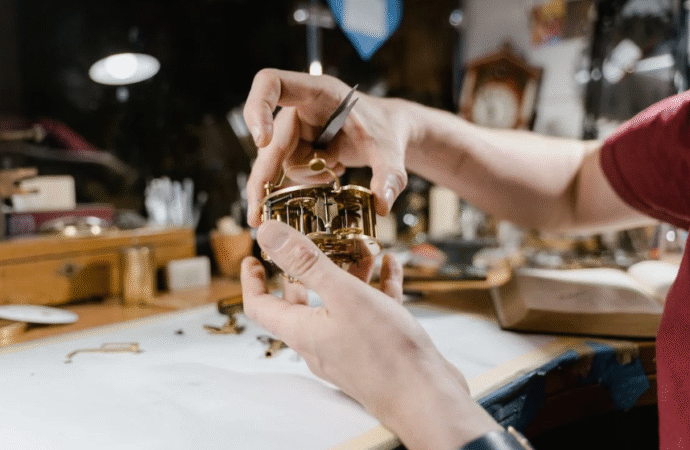I’ve had a nagging feeling in recent months that I’m a bit of a dinosaur in a certain area of fashion. The reason? I still wear a wristwatch.
By wristwatch, I don’t mean a minicomputer screen strapped above my hand from which I get texts and monitor my heartbeat and blood pressure (or whatever else they manage to do). I mean a good ol’ fashioned wristwatch – the kind that looks classy and that kids struggle to read because they’re too used to digital time.
Because of my dinosaur status in this area, I was intrigued to read an article from the L.A. Times recently and learn that classy, non-smart timepieces may be making a comeback. And with the modest revival of such watches comes the need for those who can make, maintain, and fix such creations.
But that’s where things get a bit tricky. According to the L.A. Times, watchmaking became such a niche industry in recent years that it’s difficult to find high-quality workers able to keep up with the demand. So much so, that a Rolex watch training school in Dallas is free for students, and pretty much comes with guarantee of a decent-paying job following graduation. Now that’s the kind of economic landscape that many of us would like to see more of in America!
The trouble is, watchmaking requires skill, care, preciseness, and an attention to detail. In other words, companies like Rolex need to train and retain craftsmen … and there just aren’t many craftsmen left in this world, whether in the watchmaking industry or in other fields.
Why is that? Why is it that America was once peppered with craftsmen who built quality furniture that was passed down as heirlooms, constructed modest homes that were full of intricate details that now only the wealthy can afford, and wove timeless clothing that lasted decades, rather than unraveling after a few washes? And why do we no longer see that type of work?
The answer to the craftsman’s disappearance is likely found in the way we now approach the concept of labor.
For many today, work is just a place where we show up and put in our time, a mentality exacerbated just a few short years ago when we were told workers were either “essential” or “non-essential.” In other words, work is simply a way to get money to pay the bills and buy a little pleasure for a short season.
Such an attitude was observed by Richard Weaver in his famous work, “Ideas Have Consequences.” “When utilitarianism becomes enthroned and the worker is taught that work is use and not worship,” Weaver wrote, “interest in quality begins to decline.”
By contrast, the worker who sees his job as a craft, pouring himself into it, will have a different outcome.
“Before the age of adulteration it was held that behind each work there stood some conception of its perfect execution. It was this that gave zest to labor and served to measure the degree of success. … Pride in craftsmanship is well explained by saying that to labor is to pray, for conscientious effort to realize an ideal is a kind of fidelity. The craftsman of old time did not hurry, because the perfect takes no account of time and shoddy work is a reproach to character. But character itself is an expression of self-control, which does not come of taking the easiest way. … There is a difference between expressing one’s self in forma and producing quantity for a market with an eye to speculation.”
Those are some lofty words, but essentially, it seems that Weaver is saying that if we want to see a return of quality, lasting products, we must first begin recultivating the concept of craftsmanship.
With that in mind, what if instead of speed, efficiency, and quantity being our main goals in the working world, we began striving for perfection and a job well done?
What if instead of tolerating showing up and surviving until quitting time – in both ourselves and our employees – we sought to create excitement and enthusiasm for the labor we do, the mission and goal we’re all working toward together?
And finally, what if we began recognizing that our work is a reflection of our internal character? Would we see greater quality and perfection in our external work if we first worked on developing self-control and other virtues in our innermost beings?
—
The republication of this article is made possible by The Fred & Rheta Skelton Center for Cultural Renewal.
Image Credit: Pexels
18 comments















18 Comments
KarenB
August 5, 2025, 11:57 amI get paid over 220 Dollars per hour working from home with 2 kids at home. i never thought i’d be able to do it but my best friend earns over 15k a month doing this and she convinced me to try. it was all true and has totally changed my life. This is what I do, check it out by Visiting Following Website…
REPLY.
.
HERE—————⊃⫸ https://Www.Cash43.Com
RSLewis@KarenB
August 5, 2025, 11:58 amGoogle is now paying $300 to $500 per hour for doing work online work from home. Last paycheck of me said that $20537 from this easy and simple job. Its amazing and earns are awesome. No boss, full time freedom and earnings are in front of you. This job is just awesome. Every person can makes income online with google easily….
REPLY.
More Details For Us→→→ http://Www.Payathome9.Com
Xaviera Raskop@RSLewis
August 6, 2025, 2:12 pmHome cash earning job to earns more than $500 per day by working for 3 to 4 hours. Getting paid weekly more than $4.5k or more simply doing easy work online. No special skills required for this job and regular earning from this are just awesome.
REPLYGOOD LUCK .:)
For more detial visit↠↠☛ http://EarnApp1.Com
groger@KarenB
August 5, 2025, 1:43 pmI’m making $23000 to $29000 a month working part time. I kept hearing other people tell me how much money they ws can make online so I decided to look into it. Well, it was all true and has totally changed my life. First month i received $24758 just working on the laptop for 3 hours per day.
This is what I do…………www.get.money63.com
REPLYandrew@KarenB
August 6, 2025, 6:40 amJOIN US Everybody can earn 250/h Dollar + daily 1K… Y You can earn from 6000-12000 Dollar a month or even more if you work as a part time job…It’s easy, just follow instructions on this page, read it carefully from start to finish… It’s a flexible job but a good eaning opportunity.tab for more detail thank you……..
REPLYFor details check ——-⫸ http://www.get.money63.com
Lauren Gregory@KarenB
August 6, 2025, 9:25 amWith joy in my heart and gratitude to God almighty i have come to tell the general public that Lord Gerald herbal medicine is the best remedy for Herpes and HIV/AIDS, I was a carrier of Herpes virus and I saw a testimony on how Lord Gerald cure Herpes, I decided to have a contact with him and asked him for help and he started the remedies for my health and prepare the herbal medicine for me which i use to cure myself. Thank God, now everything is fine, I’m cured by Lord Gerald herbal medicine, I’m very thankful to Lord Gerald and i will not stop publishing his name on the internet because of the good work he did for me, You can reach him on his email: [email protected] or
WhatsApp: +14242983869
LORD GERALD CAN AS WELL CURE THE FOLLOWING DISEASE:-
1. HIV/AIDS
2. HERPES
3. CANCER OF ALL KINDS
4. HSV
5. Hepatitis A,B,C
6. Diabetes
7. Parkinson’s disease
8. C.O.P.D
9.ALS
10. Coronary Artery Disease (Ischemic Heart Disease)
11. Alopecia
12.Bipolar disorder
13.Bedwetting
14.Carpal tunnel syndrome
15.Celiac disease
16.Ear Infections
17.Endometriosis
18.Epilepsy
19.Chlamydia
20.Syphilis
21.Gonorrhea
Natural remedy for curing HERPES and HIV. WhatsApp Lord Gerald on +14242983869
REPLYilliana
August 5, 2025, 12:11 pmSingle Mom Reveals How She Earns $89k/Yr Working 10 Hrs/Week From Home. Tired of paycheck-to-paycheck living? Meet Kelly from New York—a regular mom who cracked the code to recession-proof income without selling a thing! Now, YOU can too with the Home Profit System:
REPLYACT NOW➢ http:/Www.join.money63.com
illiana
August 5, 2025, 12:11 pmSingle Mom Reveals How She Earns $89k/Yr Working 10 Hrs/Week From Home. Tired of paycheck-to-paycheck living? Meet Kelly from New York—a regular mom who cracked the code to recession-proof income without selling a thing! Now, YOU can too with the Home Profit System:
REPLYACT NOW➢ http:/Www.join.money63.com
andrew
August 6, 2025, 2:52 amɪᴍ ᴍᴀᴋɪɴɢ ᴏᴠᴇʀ 𝟷𝟹ᴋ ʙᴜᴄᴋs ᴀ ᴍᴏɴᴛʜ ᴡᴏʀᴋɪɴɢ ᴘᴀʀᴛ ᴛɪᴍᴇ. ɪ ᴋᴇᴘᴛ ʜᴇᴀʀɪɴɢ ᴏᴛʜᴇʀ ᴘᴇᴏᴘʟᴇ ᴛᴇʟʟ ᴍᴇ ʜᴏᴡ ᴍᴜᴄʜ ᴍᴏɴᴇʏ ᴛʜᴇʏ ᴄᴀɴ ᴍᴀᴋᴇ ᴏɴʟɪɴᴇ sᴏ ɪ ᴅᴇᴄɪᴅᴇᴅ ᴛᴏ ʟᴏᴏᴋ ɪɴᴛᴏ ɪᴛ. ᴡᴇʟʟ, ɪᴛ ᴡᴀs ᴀʟʟ ᴛʀᴜᴇ ᴀɴᴅ ʜᴀs ᴛᴏᴛᴀʟʟʏ
ᴄʜᴀɴɢᴇᴅ ᴍʏ ʟɪғᴇ…..➤➤ http://www.get.money63.com
REPLYStrasser
August 6, 2025, 3:27 amI get paid more than $120 to $130 per hour for working online. I heard about this job 3 months ago and after joining this i have earned easily $15k from this without having online working skills.
This is what I do…….www.best.work43.com
REPLY